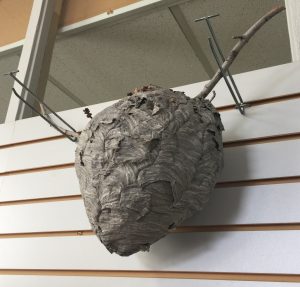As summer moves into August a very busy pest has been growing its nest size slowly over the months of June and July. As the flowers and other natural food sources start to disappear, the move from the natural sugars and nectars from these food sources dry up and the need for proteins and carbohydrates increase. This is where the yellow jackets and the black and white wasps become more aggressive in finding alternative food sources. These alternatives include your soft drinks, meats, vegetables and any type of food that you may have been cooking in your backyard. Wasps do not have a barb on their stinger so when they come in to get a piece of your steak, if they are scared they will start stinging you many times and release a pheromone to make other wasps in the area come and sting you as well. It’s important to stay calm when wasps are flying around you as any fast movements may set off the alarm pheromone and make you a target to be stung.
We have many the counter products that can be used to treat wasp nests. Only use products that are registered for the control of wasps because using a pesticide to kill a pest that is not on label is against the law and you may be putting yourself and bystanders at risk of an improper application of insecticide. Using a liquid or foam spray will provide a direct and instant kill on contact.
The first thing you will need to do is find the nest. Wasp nests range in colour from light to dark grey and can range in size from a teacup, to a small baseball or even larger than a basketball. Some nests can be found in walls, cracks in walls, and even in the ground. Watch the nest during the day and find where the wasps are entering and exiting, the entrance hole will be near the bottom of the nest. The best time to treat a wasp nest is either early in the morning or late evening when most wasps are inside and resting. If the nest is hidden, the entrances must be dusted with an appropriately label insecticide dust. This method takes several hours in order for the nest to be killed. The wasps will clean each other off, as they are social insects, and the dust kills the entire nest.
You will need to keep an eye on the wasps that are tasked with protecting the nest, if they sense a presence these wasps will come out to investigate. You can spray any wasps outside of the nest with insecticide when you are approaching. If you need a ladder to reach the nest, ensure that it is well secured before attempting to spray a wasp nest.
When treating the nest with a foam spay, shake the can before using and make sure the wind is at your back so you don’t get any spray blown on you. Begin by spraying inside the bottom hole of the wasp nest. You can spray the entrance hole from up to 6 – 8 feet away with this product, so you don’t have to get too close. Continue spraying until the opening of the nest is completely covered with insecticide foam.
The foam spray comes with an extension tube that can be attached to the nozzle. Use this tube and poke into the nest to get the spray inside. You will want to spray into several spots around the nest. When attaching the tube, point the actuator button away from your face.
After a few minutes, the nest will be ready to be knocked down and disposed of. After removing the nest, you may see several eggs inside that were getting ready to hatch!
At Poulin’s we are trained to remove wasp nests during the day when control is much more difficult, but successful. If you need assistance in removing a wasp nest visit any of our stores across western Canada or call us to speak with one of our experts toll-free at 1-888-768-5467.

